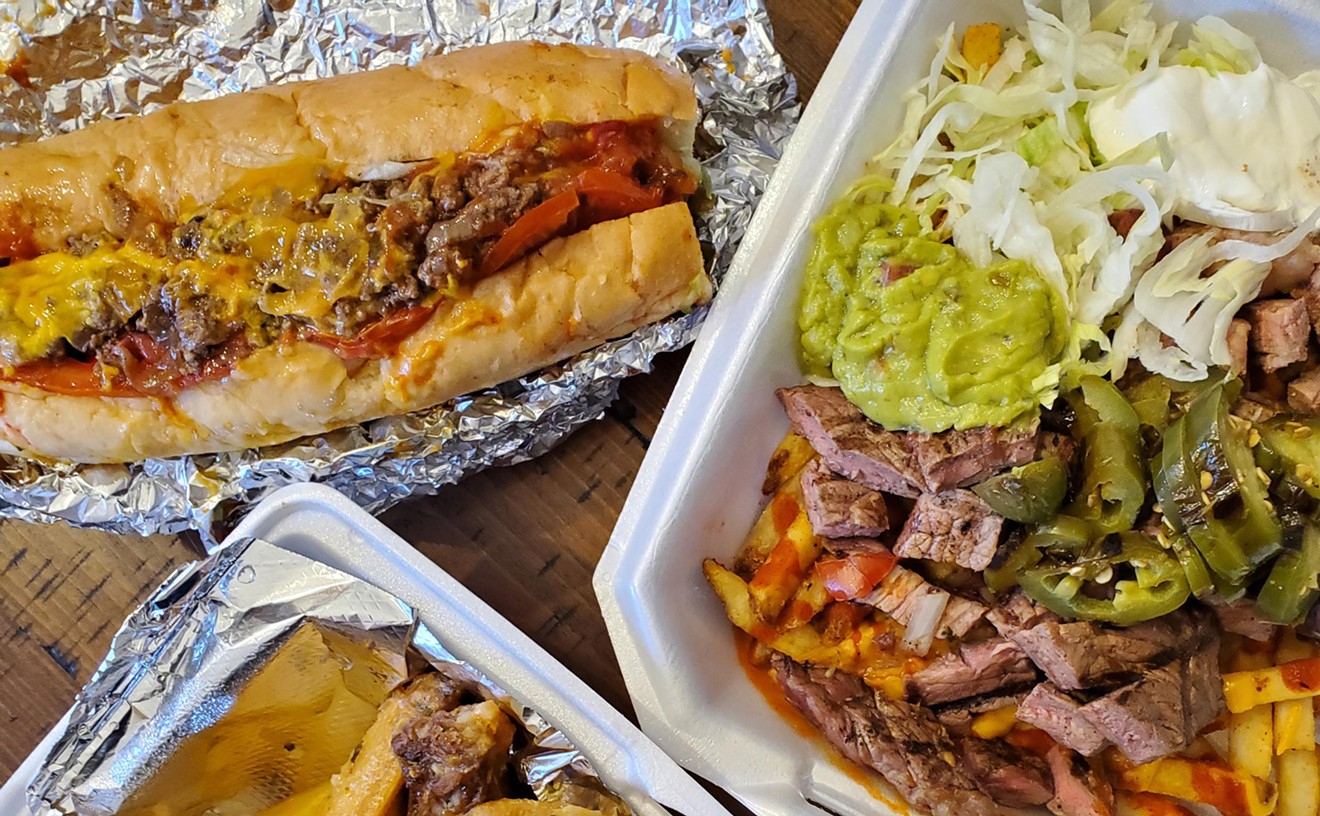Gourmet magazine was launched in 1941, the same year that M&Ms made their debut, and what the New Yorker called "the world's most distinguished restaurant," Pavillon, opened in New York. Two years later, Pizzeria Uno started making deep-dish pies on Chicago's North Side; corn dogs were invented in 1945 at the Texas State Fair. In 1946, a triple whammy: The Culinary Institute of America, our first serious cooking school, opened; James Beard's I Love to Eat, the original cooking show, aired on television; and Diners Club started issuing credit cards to meet the demands of savvy restaurant-goers.
The Forties were also the heyday of the supper club, an early eatertainment response to Americans tired of rationing butter and cheese and looking for some way to cut loose and celebrate the end of the war. Supper clubs, many of them members-only, combined music and dancing with fancy food prepared by French chefs, food that had never before been seen on this side of the ocean (except in a few hoity-toity places like Chicago's Pump Room). At these clubs, the service was supposed to make diners feel as though they had their own personal butlers and maids, the musicians were the best in their fields, and the cost was quite hefty for the times--dinner for two often ran as high as $50, including tip, a bottle of wine and four courses. But those courses might include dishes as novel as truffle-stuffed quail, filet mignon Caesar Augustus and coconut hot-fudge snowballs, all impeccably prepared by a legion of kitchen staffers, some of whom spent their entire evening doing nothing but slicing ham for chicken cordon bleu.
Not surprisingly, 1949 saw the beginning of the first major study to link high cholesterol levels to heart disease.
Five decades later, a year from the millennium and many years into heart-healthy eating, Denver restaurateur Bobby Rifkin has inexplicably revived the supper-club concept at Pacific Star Supper Club. Even more inexplicable is the Pacific Rim cuisine. While many GIs may have smelled it during their tours of duty in the Pacific, it was hardly traditional supper-club fare, and it's an even stranger choice for an upscale restaurant in a town that already knows the joys of inexpensive satay and tempura.
The atmosphere is convincing, though. The decor bridges the years between the Forties and today by mixing art deco--colored with the elegance of gold and burgundy and set off by a white baby grand in the bar area--with modern touches. There are also vintage supper-club features, such as fresh flowers, tiny lamps on the tables and a setup that allows some diners (they used to be the ones who slipped the matre d' some cash, but I didn't see any evidence of that here) to sit right in front of the dance floor and stage. Rifkin, who owns the Diamond Cabaret Steakhouse, and co-owner Jerry Kernis obviously spared no expense when they opened this posh place last November in the space once occupied by Zenith American Grill. In addition to splurging on the physical surroundings, they brought in two restaurant heavy-hitters: Cliff Young (a pal of Rifkin's), who runs the front of the house, and talented chef Sean Brasel, most recently of Ilios, to create the menu and run the kitchen.
The first time I visited Pacific Star, it was during the annual Girls' Night Out for six moms who live in my area--so we were all fresh from another kind of war. A supper club seemed just the escape we needed. Our limo pulled up, and we stepped into the splendor that is Pacific Star's dining room. The dishes are clearly intended to mirror that opulence--if not its origins--with most offering elaborate, fussed-with presentations. For example, the shrimp tempura ($9.95) featured crispy crustaceans that had been coated in a heavy, heavy tempura batter and deep-fried, then assembled into some sort of Lincoln Log-like structure. They were served with a peach-flavored ponzu sauce--the "ponzu" part here meant soy, soy and more soy--and a too-thick but tasty red-pepper jam.
The other appetizers were less spectacular in presentation and equally disappointing in production. The bland, watery Chinese dumplings ($6.95) came with a sauce that was supposed to be spicy black bean and ginger but tasted only of the latter and even then had no bite. The lobster pancake ($12.95) was like a bloated omelette--we all fought over the two claws' worth of meat. And the shrimp wontons ($8.95)--listed on the menu as "our Chef's favorite appetizer!"--consisted of five chewy wontons served with an alleged wild-mushroom-and-papaya salsa, but I couldn't discern any wild-mushroom taste. The best of the bunch was the Thai beef satay ($7.50): skewers of tender, succulent beef well-seasoned with ginger, lemongrass and chiles and served with a wild-mushroom slaw that not only tasted of wild mushrooms, but did so wonderfully, with just a hint of vinegar.
For the prices Pacific Star charges, we expected better. And the way-above-average price tags on our entrees definitely raised expectations. But I've had better Peking duck at a local Chinese restaurant for half the price. Pacific Star's Peking duck ($24.95) had been marinated in ginger and brown sugar rather than prepared the traditional way, which calls for blowing air into the space between the skin and the flesh and stuffing it with spices, soy, garlic and leeks before roasting the bird. The crisp skin that results is usually the best part of Peking duck. Pacific Star's version had moist meat (just a few medallions, rather than the standard half-duck), no crisp skin and a side of Asian ginger-plum salsa that was mouth-puckeringly tart.
The lobster tempura ($31.95) was another loser. A half-pound lobster tail--which, I feel compelled to point out, costs $16 a pound right now at Safeway--had been done up in that too-heavy batter, deep-fried into a stomach-turning grease pit and arranged on the plate so that it looked like a naked peacock that had just been shot in the heart, with peach ponzu and red-pepper jam oozing all over. (Fortunately, my companion did not order the four-pound Shanghai version of this dish, at $22 per.) One more overpriced entree, the tea-seasoned swordfish ($25.95), was another major disappointment, since the fish was utterly flavorless and the "tangy" mandarin oranges weren't: They seemed fresh from the can.
Our dinner had a few redeeming dishes, however. An order of sweet red-chile shrimp ($20.95) brought pan-seared shrimp sparked by a sweet chile-and-lemon marinade, although the accompanying Asian noodle salad was excessively oily. And while the chicken chop ($19.95) was dry and chewy, the buttermilk mashed potatoes beneath it were marvelous, and difficult to stop eating. The real stunner, though, was the char-grilled beef tenderloin ($29.95), one of the best slabs of meat I've ever encountered. The corn-fed Nebraska beef inspired sighs all around, as though a young Sinatra had just started crooning on the supper-club stage.
But we wouldn't demand an encore of our desserts (each $6), since only the gianduja-based warm chocolate torte drew raves. The coconut creme brulee and raspberry chocolate mousse were just okay, and the plum-wine-poached Asian pears with pear-ginger sorbet, while innovative and light, were hard for the less adventurous in the party to appreciate. And the ensuing 25-minute wait as the staff sorted out a wine overcharge--Pacific Star's fault, not ours, although the rest of the service could not have been better--forced us to leave on a sour note, just as the jazz singer launched into an incongruous Madonna song.
At lunch the place was quieter and the food was better. Brasel has always done a good job with calamari ($7.95), and Pacific Star's take was no exception. The tender squid had been kissed with a light batter--couldn't Brasel use the same approach with the tempura?--that went well with the chile-fired aioli and wasabi sauce. And the Hong Kong lobster bisque ($4.95) was rich and creamy, with just the right amount of seafood and a beautiful garnish of topeko--flying-fish roe--and crispy wonton shreds.
As tempting as it was to order the beef tenderloin again (at the reduced price of $14.95), we instead opted for sandwiches. The smoked-salmon club ($7.95), with thick-cut applewood-smoked bacon, not too much red onion and a slathering of wasabi-sparked cream cheese, came with fine waffle-style fries and a perky Asian coleslaw. The same sides arrived with the smart Asian vegetarian sandwich ($7.95), a grilled, chilled portabello layered with roasted chiles, smoked mozzarella and a fiery cilantro mayo on focaccia.
But sandwiches are easy--and not exactly the fare you're looking for at a supper club. In a town where good Asian food can be had for a song, Pacific Star fell too short on the high-ticket items--and the fact that its food comes with a song doesn't excuse sloppy execution and slipshod sauces. This isn't retro--it's regression. This city isn't ready to pay New York prices for what's essentially the same old Denver food.
We may have won the war, but Pacific Star seems to have lost its way.
Pacific Star, 1735 Lawrence Street, 303-292-5100. Hours: 11 a.m.-2 p.m., 5:30 p.m.-midnight Monday-Friday; 5:30 p.m.-midnight Saturday.










